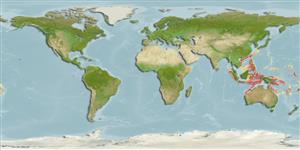Actinopterygii (ray-finned fishes) >
Pleuronectiformes (Flatfishes) >
Paralichthyidae (Large-tooth flounders)
Etymology: Pseudorhombus: Greek, pseudes = false + Greek, rhombos = paralelogram (Ref. 45335). More on author: Fowler.
Environment / Climate / Range
Ecology
Marine; bathydemersal; depth range 200 - 270 m (Ref. 9494). Deep-water, preferred ?
Western Central Pacific: Philippines, Indonesia and Australia.
Size / Weight / Age
Maturity: Lm ? range ? - ? cm
Max length : 22.0 cm SL male/unsexed; (Ref. 311)
Dorsal
spines
(total): 0;
Dorsal
soft rays
(total): 67-70;
Anal
spines: 0;
Anal
soft rays: 50 - 53. Color of preserved specimens tan to dark grey on the ocular side; tan or whitish on the blind side. Pectoral fin rays 11-13 on ocular side; 11-12 on blind side. Pelvic fin of ocular side with black spot and shorter than that on the blind side. Gill rakers elongate and pointed. 1st interhemal spine stout.
Inhabits mud and sand bottoms (Ref. 9774). Feeds on crustaceans and other benthic invertebrates (Ref. 9774).
Life cycle and mating behavior
Maturity | Reproduction | Spawning | Eggs | Fecundity | Larvae
Distinct pairing (Ref. 205).
Hensley, D.A. and K. Amaoka, 1989. A redescription of Pseudorhombus megalops, with comments on Cephalopsetta ventrocellata (Osteichthyes: Pleuronectiformes: Paralichthyidae). Proc. Biol. Soc. Wash. 102(3):577-585. (Ref. 2688)
IUCN Red List Status (Ref. 115185)
CITES (Ref. 94142)
Not Evaluated
Threat to humans
Harmless
Human uses
More information
ReferencesAquacultureAquaculture profileStrainsGeneticsAllele frequenciesHeritabilityDiseasesProcessingMass conversion
Tools
Special reports
Download XML
Internet sources
